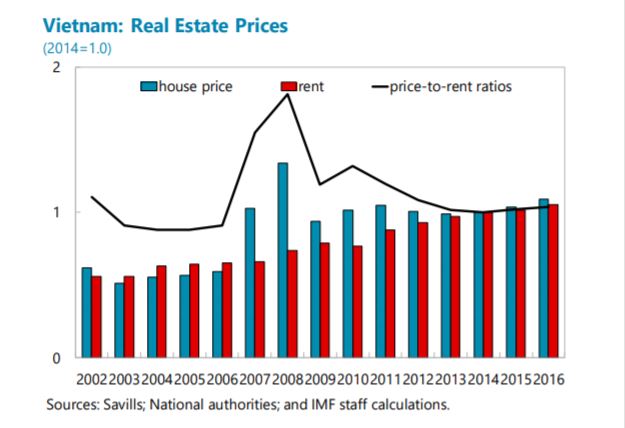Friday, July 13, 2018
House Prices in Vietnam
From the IMF’s latest report on Vietnam:
“Real estate prices have rebounded from the lows seen in the GFC but remain well below the
highs of 2008. Price-to-rent ratios suggest that the increase in property prices is in line with growing demand for housing from a rapidly growing urban middle class with rising incomes (…). The availability of affordable housing is also increasing, supported in part by low-interest mortgage lending by SOCBs.”
From the IMF’s latest report on Vietnam:
“Real estate prices have rebounded from the lows seen in the GFC but remain well below the
highs of 2008. Price-to-rent ratios suggest that the increase in property prices is in line with growing demand for housing from a rapidly growing urban middle class with rising incomes (…). The availability of affordable housing is also increasing, supported in part by low-interest mortgage lending by SOCBs.”
Posted by at 8:27 AM
Labels: Global Housing Watch
Macroprudential Policy: Implementation, Effects, and Lessons
From a new paper by Bank of Israel and Hebrew University:
“In this paper I overview the development of macroprudential policy (MPP) and, in particular, its regulatory structure, its influence on the financial system, and its costs and benefits. I find that the effectiveness of MPP depends on the institutional setup in which it is implemented it: often, MPP is under the responsibility of the central banks, but this setup may generate conflicts between MPP and traditional monetary policy. I also discuss another issue undermining the effectiveness of MPP, namely, “leakages,” migrations of financial activity outside the scope of application and enforcement of the MPP tool. Based on the Israeli experience of implementing MPP, I argue that coordination between the regulatory authorities supervising different segments of the financial system is crucial for the successful implementation of MPP.”
From a new paper by Bank of Israel and Hebrew University:
“In this paper I overview the development of macroprudential policy (MPP) and, in particular, its regulatory structure, its influence on the financial system, and its costs and benefits. I find that the effectiveness of MPP depends on the institutional setup in which it is implemented it: often, MPP is under the responsibility of the central banks, but this setup may generate conflicts between MPP and traditional monetary policy.
Posted by at 8:18 AM
Labels: Global Housing Watch
Housing View – July 13, 2018
On cross-country:
- European House Prices Tell Very Different Economic Tales: Chart – Bloomberg
On the US:
- Homeownership Aspirations: The Enduring, But Evolving, American Dream – Zillow
- Even fully employed and moderate income households struggle to-pay the rent – Harvard Joint Center for Housing Studies
- How a Tiny Bank From the Ozarks Got Big and Outpaced Wall Street’s Real Estate Machine – Bloomberg
- Housing an Aging Region – Urban Institute
- Building and Protecting Affordable and Adequate Rental Housing – Urban Institute
- Rebuilding and Sustaining Homeownership for African Americans – Urban Institute
- Tackling Southeast Michigan’s Biggest Housing Challenges – Urban Institute
- The state of millennial homeownership – Urban Institute
- Under US housing policies, homeowners mostly win, while renters mostly lose – Brookings
- Pentagon Says It Won’t Pay for Housing of Immigrants – Foreign Policy
- Trying to Cut Crime in Public Housing by Making It More Livable – New York Times
- Labor Demand Shocks and Housing Prices across the US: Does One Size Fit All? – Institute of Labor Economics
- House Money: Wall Street Is Raising More Cash Than Ever for Its Rental-Home Gambit – Wall Street Journal
- Americans Burdened by Increasing Housing Costs, Slow Wage Gains – Bloomberg
- Shared Prosperity (or Lack Thereof) in the Sharing Economy – Purdue University, Washington Post
On other countries:
- [Australia] Australian Tightening of Property Loan Standards Mostly Over – Bloomberg
- [Canada] Toronto And Vancouver Top-Tier Housing Markets Headed In Opposite Directions: Sotheby’s – Huffington Post
- [Canada] Vancouver, Can We Talk About Housing Without Getting So Angry? – The Tyee
- [China] Why women own less housing assets in China? The role of intergenerational transfers – Journal of Housing and the Built Environment
- [China] China scales back property subsidies, adding to growth concerns – Financial Times
- [China] China: An Uneven Housing Market – Continuum Economics
- [China] China to restrict subsidies for shantytown redevelopment projects – Reuters
- [Japan] Lack of supply drives rise in Kyoto’s property prices – Financial Times
- [Singapore] Three Charts That Help Explain Singapore’s New Property Curbs – Bloomberg
- [Spain] El precio del alquiler en España sigue sin encontrar techo – Reuters
- [Singapore] Singapore’s Cooling Measures and Its Housing Market – Journal of Housing Economics
- [United Kingdom] Bank of England should aim to freeze house prices for five years – report – Guardian
Photo by Aliis Sinisalu
On cross-country:
- European House Prices Tell Very Different Economic Tales: Chart – Bloomberg
On the US:
- Homeownership Aspirations: The Enduring, But Evolving, American Dream – Zillow
- Even fully employed and moderate income households struggle to-pay the rent – Harvard Joint Center for Housing Studies
- How a Tiny Bank From the Ozarks Got Big and Outpaced Wall Street’s Real Estate Machine – Bloomberg
- Housing an Aging Region – Urban Institute
- Building and Protecting Affordable and Adequate Rental Housing – Urban Institute
- Rebuilding and Sustaining Homeownership for African Americans – Urban Institute
- Tackling Southeast Michigan’s Biggest Housing Challenges – Urban Institute
- The state of millennial homeownership – Urban Institute
- Under US housing policies,
Posted by at 8:05 AM
Labels: Global Housing Watch
Thursday, July 12, 2018
Financial globalisation and the welfare state
A new VOX column by Assaf Razin and Efraim Sadka argues that “Financial globalisation shifts the tax burden away from the mobile factor – i.e. domestic capital – to the immobile factor – i.e. labour. However, the total tax burden becomes smaller, and consequently the provision of the social benefit is reduced. These results obtain regardless of which skill type form the majority. Naturally, the tax rates on capital and labour are higher when a low-skilled type form the majority than when the high-skilled type forms the majority. […] the welfare system, either under the high-skilled regime or under the low-skilled regime, acts as a device that compensates the loser at the expense of the winner in such a way that financial globalisation generates Pareto-improving changes.”
In my recent paper with Davide Furceri and Jonathan Ostry, we find that financial globalisation has led, “on average, to limited output gains while contributing to significant increases in inequality. Behind this average lies considerable heterogeneity according to country characteristics. Liberalization increases output in countries with high financial depth and that avoid financial crises (and vice-versa), but distributional effects are more pronounced in countries with low financial depth and inclusion, and whose liberalization is followed by a financial crisis.” My paper is available here.
A new VOX column by Assaf Razin and Efraim Sadka argues that “Financial globalisation shifts the tax burden away from the mobile factor – i.e. domestic capital – to the immobile factor – i.e. labour. However, the total tax burden becomes smaller, and consequently the provision of the social benefit is reduced. These results obtain regardless of which skill type form the majority. Naturally, the tax rates on capital and labour are higher when a low-skilled type form the majority than when the high-skilled type forms the majority.
Posted by at 5:55 PM
Labels: Inclusive Growth
Friday, July 6, 2018
Climate Change and NYU Volatility Institute
From Francis Diebold’s Blog:
“There is little doubt that climate change — tracking, assessment, and hopefully its eventual mitigation — is the burning issue of our times. Perhaps surprisingly, time-series econometric methods have much to offer for weather and climatological modeling (e.g., here), and several econometric groups in the UK, Denmark, and elsewhere have been pushing the agenda forward.
Now the NYU Volatility Institute is firmly on board. A couple months ago I was at their most recent annual conference, “A Financial Approach to Climate Risk”, but it somehow fell through the proverbial (blogging) cracks. The program is here, with links to many papers, slides, and videos. Two highlights, among many, were the presentations by Jim Stock (insights on the climate debate gleaned from econometric tools, slides here) and Bob Litterman (an asset-pricing perspective on the social cost of climate change, paper here). A fine initiative!”
From Francis Diebold’s Blog:
“There is little doubt that climate change — tracking, assessment, and hopefully its eventual mitigation — is the burning issue of our times. Perhaps surprisingly, time-series econometric methods have much to offer for weather and climatological modeling (e.g., here), and several econometric groups in the UK, Denmark, and elsewhere have been pushing the agenda forward.
Now the NYU Volatility Institute is firmly on board.
Posted by at 5:32 PM
Labels: Energy & Climate Change, Forecasting Forum
Subscribe to: Posts






